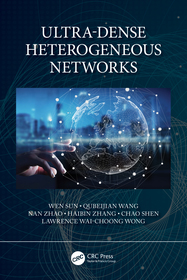
Ultra-Dense Heterogeneous Networks
-
10% KEDVEZMÉNY?
- A kedvezmény csak az 'Értesítés a kedvenc témákról' hírlevelünk címzettjeinek rendeléseire érvényes.
- Kiadói listaár GBP 105.00
-
50 163 Ft (47 775 Ft + 5% áfa)
Az ár azért becsült, mert a rendelés pillanatában nem lehet pontosan tudni, hogy a beérkezéskor milyen lesz a forint árfolyama az adott termék eredeti devizájához képest. Ha a forint romlana, kissé többet, ha javulna, kissé kevesebbet kell majd fizetnie.
- Kedvezmény(ek) 10% (cc. 5 016 Ft off)
- Kedvezményes ár 45 147 Ft (42 998 Ft + 5% áfa)
Iratkozzon fel most és részesüljön kedvezőbb árainkból!
Feliratkozom
50 163 Ft

Beszerezhetőség
Becsült beszerzési idő: A Prosperónál jelenleg nincsen raktáron, de a kiadónál igen. Beszerzés kb. 3-5 hét..
A Prosperónál jelenleg nincsen raktáron.
Why don't you give exact delivery time?
A beszerzés időigényét az eddigi tapasztalatokra alapozva adjuk meg. Azért becsült, mert a terméket külföldről hozzuk be, így a kiadó kiszolgálásának pillanatnyi gyorsaságától is függ. A megadottnál gyorsabb és lassabb szállítás is elképzelhető, de mindent megteszünk, hogy Ön a lehető leghamarabb jusson hozzá a termékhez.
A termék adatai:
- Kiadás sorszáma 1
- Kiadó CRC Press
- Megjelenés dátuma 2022. szeptember 14.
- ISBN 9780367709501
- Kötéstípus Keménykötés
- Terjedelem134 oldal
- Méret 234x156 mm
- Súly 320 g
- Nyelv angol
- Illusztrációk 40 Illustrations, black & white; 40 Halftones, black & white; 1 Tables, black & white 295
Kategóriák
Rövid leírás:
This book will investigate the service and QoE provisioning in ultra-dense heterogeneous networks. It covers definitions, characteristics, requirements, resource management, mobile management, inference management, enabling factors, integration with enabling technologies and future directions and challenges.
TöbbHosszú leírás:
Driven by the ever-increasing amount of mobile data, cellular networks evolve from small cell network to ultra-dense heterogeneous networks, to provide high system capacity and spectrum efficiency. By bringing base stations (BSs) to the approximate spatial scale and number magnitude, ultra-dense heterogeneous networks would definitely bring unprecedented paradigm changes to the network design. Firstly, along with densification of small cells, inter-cell interference becomes severe and may deteriorate performance of mobile users. Assigning network resources including bandwidth and time slots, while avoiding interference, desires serious consideration. Secondly, the coverage area of BSs becomes small and irregular, resulting in much frequent and complicated handovers when mobile users move around. How to ensure continuous communication and implement effective mobility management, and inter-cell resource allocation and cooperation, remains a challenging issue. Thirdly, such dynamic change in spatial dimension enables us to re-investigate available and ongoing communications and networking techniques, such as massive MIMO, CoMP, millimeter waves (mmWaves), carrier aggregation, full duplex radio, and D2D communications.
To address the aforementioned challenging research issues, this book will investigate the service and QoE provisioning in ultra-dense heterogeneous networks. In particular, firstly we introduce ultra-dense heterogeneous networks by careful definition regarding spatial deployment, generic characteristics, and requirements of ultra-dense heterogeneous networks in order to ensure QoE of mobile users. Secondly, we depict the resource management among small cells in close proximity, mobility management for mobile users (address the super-frequent handovers), and interference management (dealing with the interference due to frequency-reuse in the vicinity). Thirdly, we study the enabling factors, and the integration of ultra-dense heterogeneous networks with enabling technologies, such as massive-MIMO, cloud-RAN, mmWaves, D2D, IoT. Finally, we conclude the book and indicate future directions and challenges.
TöbbTartalomjegyzék:
1. Introduction 2. Resource and Interference management 3. Mobility Management 4. Enabling Factors and Emerging Techniques 5. Promising Applications 6. Summary and Future Work
Több



